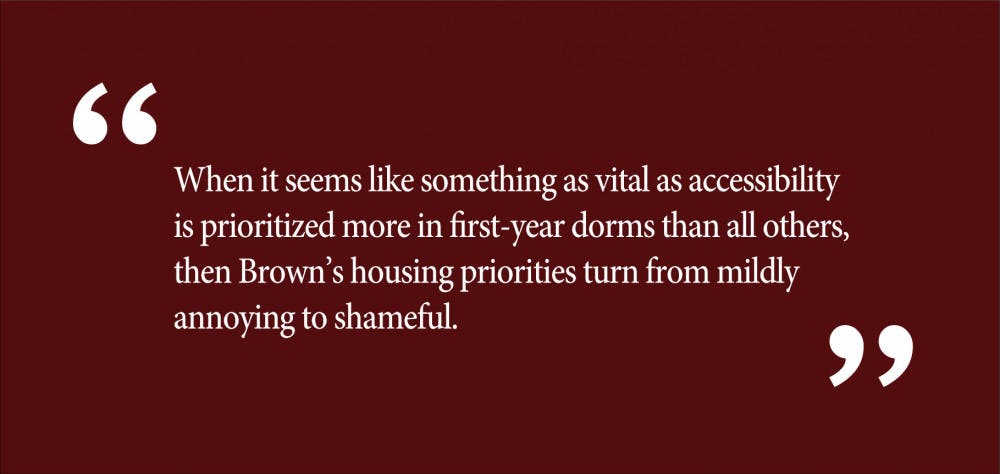Twenty-four million dollars later, and the building formerly known as Wilson Hall has completed its transformation into the sleek, modern, fully accessible Friedman Hall. This is a welcome change, coming to fruition almost three years after students in PHP 1680I: “Pathology to Power: Disability, Health and Community” drew attention to the challenges faced by students with limited mobility when trying to access it. But this is just the first step necessary to making Brown a fully accessible campus. Going forward, I urge the administration to prioritize renovations of residential halls to build a more inclusive community.
It’s hard to overexaggerate the inaccessibility of student living spaces on Brown’s campus. Of the 58 dorms listed on the official Residence Hall Map, 26 receive scores of “0” on the Campus Accessibility Map provided by Facilities Management: 111 Brown St.; 219 Bowen St. (Donovan House); Grad Center A-D; Hegeman A-E; Hope College; King House; Littlefield Hall; Minden Hall; New Pembroke 1-4; North, Middle and South Caswell; Slater Hall; West House; and Young Orchard 4 and 10. This means that in all of those buildings, “a physical barrier exists that would prevent a wheelchair user from entering the facility.” Some, like Minden, might have elevators once you make it inside, or, like Hegeman E, will have wheelchair-accessible bathrooms if you can somehow make it to the second floor with no entrance ramp or elevator. But they all fail the basic test of allowing people with limited mobility to easily get inside. Based on the rooms listed in the 2015-2016 housing lottery, at least 1,175 students are living in these spaces. That’s approximately 18 percent of Brown’s undergraduate population — and the percentage only gets higher if you are specifically looking at undergraduates living on campus.
It is also worth noting that of the residential halls listed above, only one of the New Pembroke buildings is (sometimes) set aside as first-year housing. Past writers (myself included) have argued that first-year housing options are of considerably higher quality than their sophomore and upperclassmen counterparts. As Samantha Savello ’18 pointed out, “Intuitively, it would seem that Brown’s primary motivation for focusing on first-year housing at the expense of other facilities is to boost its retention rates, which are an important metric for college rankings and reputation. First-year students are less attached to the University and more likely to transfer out if they have bad experiences, including with unaccomodating or deteriorating rooms. As such, the University has done its best to make these first-year havens as comfortable as possible.”
When you’re talking about things like peeling paint or the occasional rodent problem, these can be dismissed as small-scale complaints. But in this case, this isn’t just a matter of comfort. This is a matter of being able to be a member of the community: to go to events held in residential halls, to visit your friends or to bring your friends to your space, to navigate through all floors of your building to meet your community. When it seems like something as vital as accessibility is prioritized more in first-year dorms than all others, then Brown’s housing priorities turn from mildly annoying to shameful. Upperclassmen with disabilities are as deserving as first-year students of having a wide range of housing opportunities, especially since off-campus options are even less likely to be fitted with ramps, elevators, and other necessary accommodations.
The construction that would be required to raise the accessibility scores of dorms would not be cheap or quick. But this is not an excuse for inaction. The University Accessibility page on the Residential Life website itself acknowledges the problem, albeit in an understated way, when it says, “Although some of … the improvements remain to be completed, we want to report to the community on the substantial progress that has been made in completing projects that improve the infrastructure of housing for students with disabilities.” It is of course expected that an official University website would emphasize Brown’s accomplishments, and there certainly have been improvements. But fixing some spaces in order to offer a limited array of options to students with disabilities is simply not enough, especially considering that previously able-bodied students may become injured and therefore unable to easily access their rooms. Wider options are needed.
Brown’s residential halls may meet the minimum standards set forth by the Americans with Disabilities Act for accessible dormitories — which mandates that 5 percent of the bedrooms must be handicap-accessible — but it’s time to seriously ask if that is enough. We should strive to do better than just providing such accommodations as the law requires. All University buildings should be subject to as intense and rigorous criticism as was formerly Wilson Hall — but particularly those buildings that house students and function as such vital centers of social life at Brown.
Caroline Mulligan ’19 can be reached at caroline_mulligan@brown.edu. Please send responses to this opinion to letters@browndailyherald.com and op-eds to opinions@browndailyherald.com.



